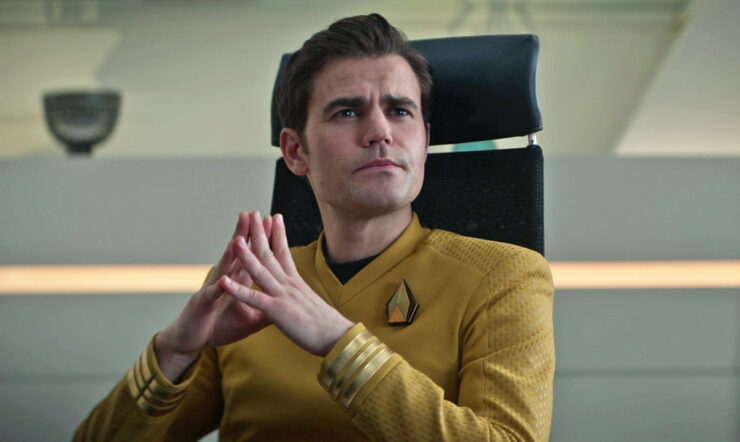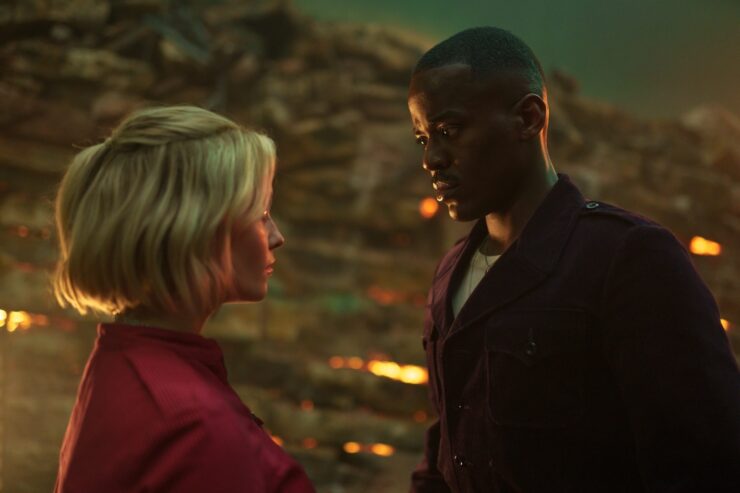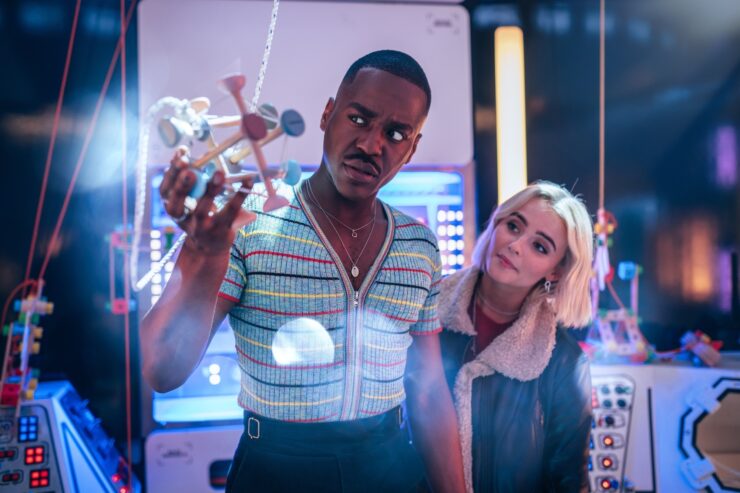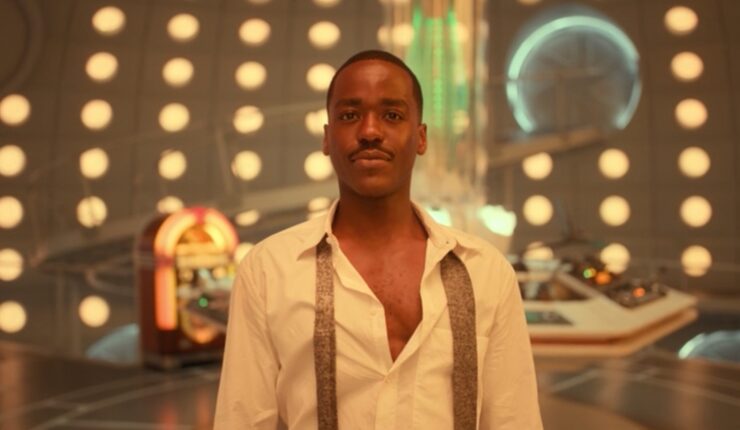When writing the script for the original series’ “Space Seed,” Gene L. Coon and Carey Wilber probably figured that setting the devastating Eugenics Wars some thirty years in the future was a safe bet. After all, television as a popular medium was less than two decades old at that point. By the time the actual 1990s rolled around, who was going to remember a line from a 1967 TV episode?
Obviously, the answer was “a lot of people.” The latest episode of SNW is a wacky time-travel adventure that is the latest attempt to reconcile Trek’s predicted future with the reality that has ensued.
The incarnations of Trek that aired during the period that Spock said the Eugenics Wars took place pretty much just ignored it. When TNG and DS9 did time travel episodes, they went to times other than contemporary-with-when-it-was-filmed Earth (“Time’s Arrow” went to the nineteenth century, “Past Tense” went to the twenty-first), and Voyager’s foray into the 1990s (“Future’s End”) made no mention of the Eugenics Wars one way or the other.
However, “Tomorrow and Tomorrow and Tomorrow” contrives to put La’an and an alternate timeline version of James T. Kirk (played once again by Paul Wesley) in twenty-first-century Toronto. The alternate timeline part happens because a time traveler (who we eventually find out is an agent from the Department of Temporal Investigations, an organization introduced in DS9’s “Trials and Tribble-ations,” but which apparently doesn’t yet exist in Pike’s era) shows up in front of La’an in an Enterprise corridor with a fatal gunshot wound. He hands a strange device to La’an, tells her to get to the bridge, and then dies. However, the temporal agent’s death results in a changed timeline. The Enterprise is in service of the United Earth Fleet, with Kirk in command. Earth is in conflict with both the Vulcans and the Romulans, and “Earth” there is largely symbolic as the planet itself is all but uninhabitable. Kirk himself has never been, having been born and mostly lived in space.
Buy the Book
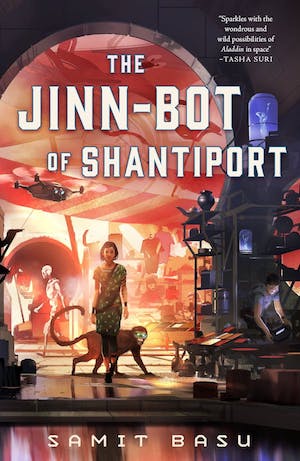

The Jinn Bot of Shantiport
Nobody recognizes La’an, and when she tries to explain herself to Kirk, he’s skeptical for obvious reasons. When she refuses to turn the device from the temporal agent over to him, he tries to grab it, and it sends them both back in time to Toronto.
(The funniest line in the entire episode, to me at least, was Kirk guessing that they were in New York City. Given the number of times that Toronto has stood in for the Big Apple in productions filmed in Canada to save money, I laughed my ass off at that one.)
For the second time, Wesley isn’t playing the Jim Kirk we all know and love from three years on live-action TV, two years on animated TV, and seven movies, but rather one from a different time track. La’an and Kirk spend a lot of time comparing their timelines, and it soon becomes evident that La’an is from the nicer one. At one point, Kirk is gobsmacked by the beauty of an Earth sunset, which he’s never seen. Later, when trying to justify why he won’t help La’an by saying his might be the more worthy timeline, La’an tartly points out that her Earth has sunsets.
That’s not what does it, though. It’s when La’an informs him that, while she’s never met her version of Kirk, she serves with his brother, and Kirk’s devastated “Sam’s alive?” changes everything.
Wesley has a difficult task in this episode, even more so than he did in “A Quality of Mercy.” In that first-season episode, there was a crisis, so there wasn’t much time for serious characterization. But the vast majority of “Tomorrow…” is him standing next to Christina Chong. And he has to be consistent with a performance that, charitably speaking, has been impersonated and lampooned unto death over the past 57 years.
The choice Wesley makes is to pick the quieter bits of William Shatner’s characterization. The Kirk he’s channeling is the one who played chess with Spock and bantered with Gary Mitchell in “Where No Man Has Gone Before,” who had a relaxed conversation with McCoy while wandering the pastoral landscape in “Shore Leave,” who took Scotty on an Argelian pub crawl at the top of “Wolf in the Fold,” who started the marriage ceremony and later quietly upbraided Stiles in “Balance of Terror.”
It helps that Wesley and Chong have superb chemistry, to the point that the inevitable kiss actually does feel earned. And the episode scored several points with me by having Kirk and La’an obtain local currency by having Kirk hustle chess. (Recall that the very first image we got of Kirk was of him kicking Spock’s ass at three-dimensional chess…)
A recently completed bridge explodes, and La’an belatedly realizes that that’s the bridge the agent wanted her to go to. However, that’s not the turning point, as both Kirk and La’an remember the bridge explosion from their respective histories.
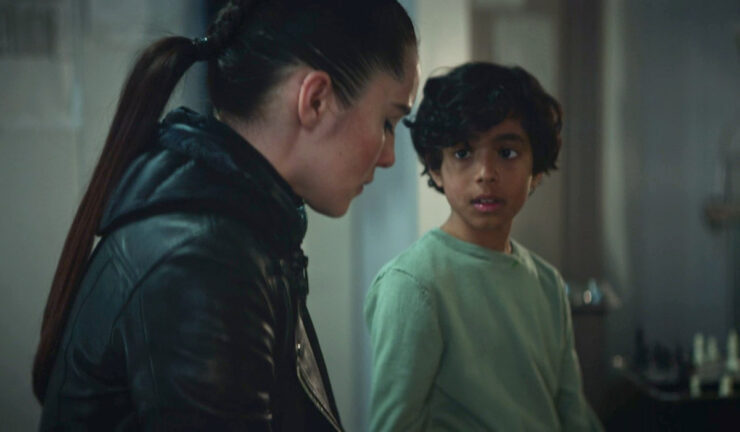
Eventually, it becomes clear why La’an in particular was chosen by the dying agent: she can get into the Noonien-Singh Institute, which is the target of our bad guys, because she has the family’s genetic markers, which enables her to get past security. That institute, which has a cold fusion generator, is the next Toronto-based target. That’s something Kirk remembers but La’an does not.
What’s more, Kirk has no response to La’an’s family name. At first, this is a character bit—La’an for the first time in her life not being judged by who she’s descended from—but it quickly becomes a plot point. The saboteur who destroyed the bridge and who plans to blow up the cold fusion generator (which destroyed all of Toronto in Kirk’s timeline) is a Romulan agent sent back in time (played by Adelaide Kane). It’s not clear what era she’s from, but she manages to tie together Enterprise and “Space Seed” by saying that tons of time travelers have tried to adjust human history around the events of the Eugenics Wars, making a reference to it supposed to have happened in 1992 and lamenting that she’s been stuck on Earth for decades, and also referring to temporal wars that were fought over humanity’s development. This officially means that scripter/consulting producer David Reed has put more thought into the Temporal Cold War that we saw throughout Enterprise’s run than anybody who wrote for Enterprise did.
(Why La’an didn’t just change her damn name remains, as ever, an exercise for the viewer…)
The Romulan time traveler—who starts out pretending to be a conspiracy theorist who thinks that Kirk and La’an are also that—wants to keep the Eugenics Wars from happening. When Kirk and La’an’s presence ruins her blow-up-the-generator plan, she goes for Plan B: kill the young child in the room that’s labelled “Khan.”
La’an manages to stop her, but not before she shoots and kills Kirk. And when confronted by the child iteration of her brutal ancestor, who caused so much suffering, but who was apparently the crucible through which the united Earth and later the Federation was born.
Amusingly, this moves everything up. Originally the Eugenics Wars were posited as World War III. Later, WW3 was altered to a twenty-first-century conflict, with the Eugenics Wars still considered to have happened in the 1990s. (Greg Cox wrote a brilliant two-book series The Eugenics Wars: The Rise and Fall of Khan Noonien Singh, which reconciled the Eugenics Wars with the real history of the 1990s. The books are brilliant, and I strongly recommend them.) Now, the third World War—which we saw the fallout of in TNG’s “Encounter at Farpoint,” the movie First Contact, and the TV series Enterprise—has gone back to being the result of the Eugenics Wars, based, not just on this episode, but what was mentioned by Pike in “Strange New Worlds” and the file Adam Soong had in hand in Picard’s “Farewell.”
And the constant time travel mishegoss is why there is such confusion. Heck, Spock himself said in “Space Seed” said that records of the time were fragmentary…
The most entertaining part of this episode, however, is the use of Pelia. We open with La’an dealing with various security issues, including the very large number of items in Pelia’s quarters, some of which seem to be stolen artifacts. When in twenty-first-century Toronto, La’an recalls Pelia saying she still has a place in Vermont, and she and Kirk go there in the hopes of getting the engineer’s help.
However, in a hilarious touch, it turns out—to La’an’s chagrin and Kirk’s bitter amusement—that Pelia didn’t start studying engineering until some time between the twenty-first and twenty-third centuries. So she’s of no direct practical help…
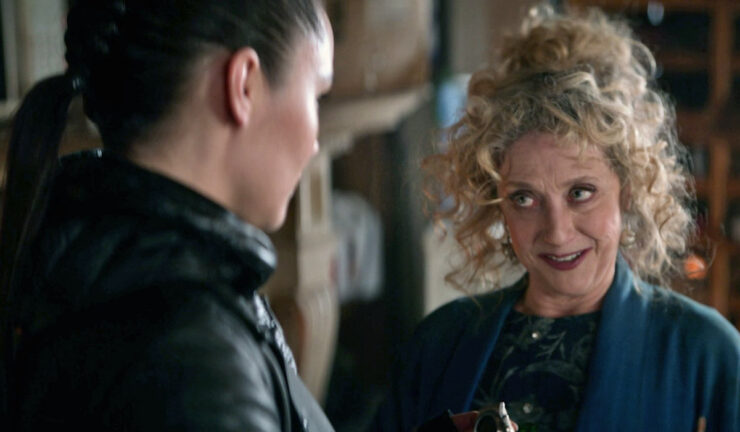
Carol Kane (no relation to Adelaide) is an absolute treasure, and her mischievous smile from “The Broken Circle” now has a bit of background to it. Gonna be fun to explore this character.
The rest of the cast gets very little to do, as it’s almost entirely a two-person play. Which is fine, mind you, as Chong and Wesley work beautifully together. It’s not clear how Spock came to even exist in Kirk’s timeline, though he’s the captain of a Vulcan warship there. (Kirk states at one poitn that he was in a Denobulan prison for a while with a Vulcan cellmate, who taught him both the neck pinch and how to make plomeek soup in the toilet, so maybe Sarek and Amanda came across each other in a prison or something…) Everybody else gets pretty much a token scene to justify their place in the opening credits. (M’Benga sparring with La’an, no doubt taking advantage of Babs Olusanmokun’s black belt in jiu-jitsu; Uhura and Ortegas on the bridge of Kirk’s alternate Enterprise; Pike and Number One having a frank discussion with Pelia about her hoarding. We never do see Chapel…)
In the end, La’an saves the timeline, and is visited by another DTI agent who cautions her against ever discussing this mission with anyone, and who also takes back the time-travel device. La’an manufactures an excuse to contact Lieutenant James T. Kirk (probably on the Farragut, though that’s not clear), thus finally allowing Wesley to play the mainline Kirk, though only briefly over a screen.
On the one hand, this is a pretty bog-standard time-travel adventure, of which Trek has had, frankly, too many. Filming in contemporary Toronto no doubt saved some money, and we had enough of this nonsense in Picard season two. And a proper examination of the ethics of killing Khan as a child never really happens. Still, it’s an engaging adventure and does some nice work with La’an. Kirk is the first person she’s dealt with who doesn’t judge her on the basis of her ancestry. For all that Kirk has an earned reputation as being somewhat prolific with women, the character has an undeniable charm that makes that busy love life pretty convincing. Wesley has at the very least a version of Shatner’s charm, and that makes his romance with La’an quite convincing. Though her breaking down and crying at the end after talking to the mainline Kirk was a bit much…
Keith R.A. DeCandido will have a short story in the historic anthology Weird Tales: 100 Years of Weird, edited by Jonathan Maberry, celebrating a century of Weird Tales magazine, now available for preorder and being released in October from Blackstone Publishing. Keith’s story is called “Prezzo,” taking place on the Lower East Side of Manhattan in the 1930s, and about Italian immigrants, racial prejudice, and scary monsters. More info here.










